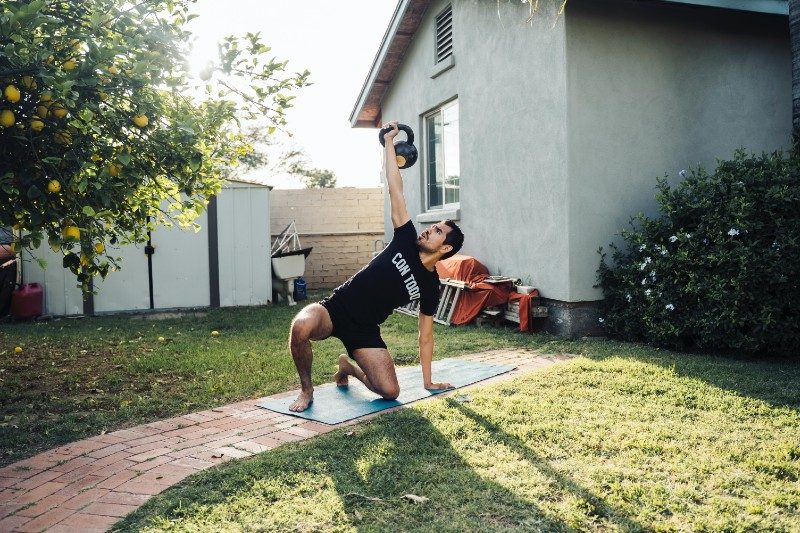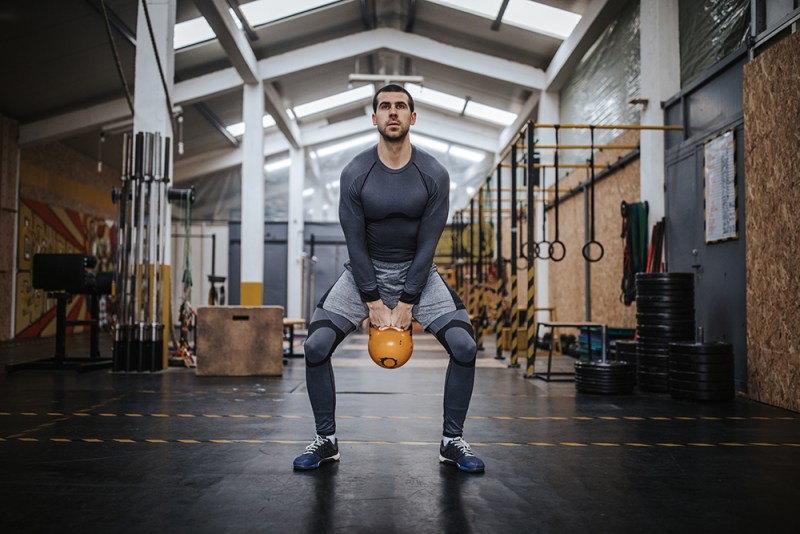
Kettlebells are like the Goldilocks of weights. While barbells are better for heavy compound lifts and dumbbells make it easier to isolate specific muscles, kettlebells activate many muscles while also improving stability because kettlebells have an offset center of gravity, making it harder to control. The result is a full-body workout with improved core strength and explosive movements that will serve you well in exercises like HIIT workouts and a myriad of sports.
“Kettlebell training methods/workouts are extremely versatile,” says professional fitness coach and former HYLETE brand ambassador, Dan Saldana. “Kettlebells are perfect for metabolic workouts, HIIT, EMOM, AMRAP, TABATA, complex training, mobility training, etc. With the kettlebell, the options are extensive, and no two training sessions will ever look the same.”
This simple, single weight is an all-in-one total body conditioning tool, so if you want to build muscle fast, incorporating kettlebells into your workout routine will help you achieve your fitness goals on your timeline. Most fitness experts would agree that the deadlift is king when it comes to effective exercises because it will build strength and muscle like no other move. The kettlebell swing is a dynamic, explosive deadlift executed in high rep counts. Make no mistake — it’s coming for the crown.
Together with fitness coach Dan Saldana, we created the following step-by-step guide to fire up that lower body and improve core strength with the best whole-body kettlebell workout routine.
Kettlebell halo
Speaking of crowns, this move reigns supreme when it comes to kettlebell exercises. This exercise helps improve the range of motion in your upper body, especially in the shoulders, which hold more tension than other parts of the body and tend to become more restricted with age.
Targeted muscles: Shoulders, trapezius, rhomboids, forearms
Sets: 3 sets of 20 reps
Execution: Stand tall, keeping the chin up and eyes looking forward. Keep the kettlebell close, focusing on stabilizing the hips and preventing them from moving. Relaxing the shoulders, allow them to move in a complete circle around your head while engaging the core.
Plank with kettlebell pull-through
Turn the classic plank up a notch with this dynamic variation. The plank with kettlebell pull-through is an anti-rotation core exercise, and the further you place the kettlebell outside of your frame, the more difficult the exercise will become.
Targeted muscles: Shoulders and core
Sets: 3 sets of 10-12 reps
Execution: Begin in a push-up position with a kettlebell by your right or left side. Keeping your chest parallel to the floor and resisting movement throughout the rest of your body, slide your arm underneath yourself to grab the kettlebell handle. Remaining in a solid plank position with your butt down and core fully engaged, pull the kettlebell underneath yourself to the other side.
Suitcase carry
This basic yet highly effective move is incredibly simple because it mimics day-to-day activities like carrying a heavy bag of groceries or kids. We tend to favor one side, so the suitcase carry is a great exercise to unilaterally train both sides of your body so that both sides become equally strong.
Targeted muscles: Forearms, core, and lower back
Sets: 3 sets of 10-12 reps
Execution: Pick up a kettlebell in either hand. Standing straight up with your core activated and shoulders rolled down and back, begin walking. As you walk, focus on using your core to stabilize your torso and prevent it from tilting over. Remember to breathe as you walk. Once you’ve walked the pre-determined distance, take a short break, switch hands, and walk back. You can go pretty heavy with these once you’ve mastered the movement, loading up to around half your own body weight.

Kettlebell swing
This classic two-handed kettlebell exercise looks like an arm workout, but all the power should really come from your legs. The perfect kettlebell swing builds total-body strength, power, and balance while also improving cardiovascular stamina.
Targeted muscles: Glutes, lower back, and core
Sets: 3 sets of 6-10 reps
Execution: Stand with your feet shoulder-width apart with a kettlebell about a foot in front of you on the ground. Hinge at the hips and grasp the kettlebell handle with both hands. Lift the kettlebell off the ground and allow it to swing back between your legs, bending your knees slightly. Keep your back flat and neck straight. Forcefully drive your hips forward to propel the kettlebell into the air. Control the kettlebell with your arms, avoiding the impulse to pull it up. The kettlebell should travel no higher than your shoulders. Control the descent by keeping your core tight.
Kettlebell single-arm windmill
This complex kettlebell exercise targets the obliques, giving you that nice deep “V” descending down from your lower torso. It’s a little awkward getting used to the windmill’s movement at first, but once you do, it’ll help boost mobility and flexibility in your hips, lower back, and legs.
Targeted muscles: Core, shoulders, hips, and thoracic spine
Sets: 3 sets of 5-8 reps each arm
Execution: Stand with your feet slightly wider than hip width, and hold the kettlebell in your left hand. Raise your left arm straight up in the air directly over your left shoulder. Slowly lower your right hand toward the ground in front of you. Once you reach the ground, your arms should form a straight line from the kettlebell to the ground. Engage your core and reverse the move back to the starting position, maintaining straight arms throughout the move.
Kettlebell Turkish getup
This advanced move targets nearly every major muscle group in the body as you transition between lying, kneeling and standing while balancing a kettlebell in the air. It is a complicated and lengthy exercise from start to finish, but it’s packed with movement control to improve balance while zeroing in on the core, hips, and shoulders.
Targeted muscles: Hamstrings, glutes, quads, hips, core, back stabilizers, trapezius, shoulder stabilizers, and forearms
Sets: 3 sets of 5-8 reps each side
Execution: Lie on your back on the floor. Extend your right arm straight over your chest, making a fist with your hand. Bend your right knee to place your foot flat on the floor. Extend your left arm 45 degrees from your side, palm facing down. Press your fist toward the ceiling as you drive your left elbow down into the floor—as if you were performing a dumbbell rowing exercise.
Use this twisting action to raise your torso off the floor and place most of your weight on your left elbow. Keep your eyes focused on your right fist the whole time. Press your left hand onto the floor to extend your elbow. Press your right heel into the floor to raise your hips up to full extension. Raise your left foot off the floor and swing it back, lowering your knee to the floor so it’s in line with the left hand. Keep looking at your right fist overhead. Your arms should form a straight line from hand to hand.
Rotate your left leg like a windshield wiper so it points straight behind you and you end up in a staggered, split stance (as in the bottom of a lunge). Extend your right leg and move your left leg forward to stand up tall — finishing with your right arm overhead as if you were holding a torch. Do everything you just did, but in reverse order to end up back at the starting position.

Incorporating a kettlebell into your workout
Using Buy at Amazon in your workout can be a fantastic way to add variety, challenge, and effectiveness to your routine. Here are some tips on how to get started with the kettlebell.
- Choose the right kettlebell weight: It’s crucial to start with a weight that’s appropriate for your fitness level. If you’re new to kettlebells, err on the side of lighter rather than heavier. A good rule of thumb is to choose a weight that you can comfortably swing for 10 to 12 repetitions with good form.
- Master the basic movements: Before diving into complex exercises, such as some of those above, focus on mastering the fundamental kettlebell movements like swings, squats, cleans, presses, and rows. These movements work multiple muscle groups at once and provide a solid foundation for more advanced exercises.
- Start with simple workouts: Once you’ve got the hang of the basic movements, you can start putting together simple workouts. Begin with two to three exercises, performing 2-3 sets of 8-12 repetitions each. Gradually increase the number of exercises, sets, and repetitions as you get stronger.
Once you’ve done all the above steps to begin working with a kettlebell, you’re ready to add it to your normal workout routine and do all the exercises described above.



